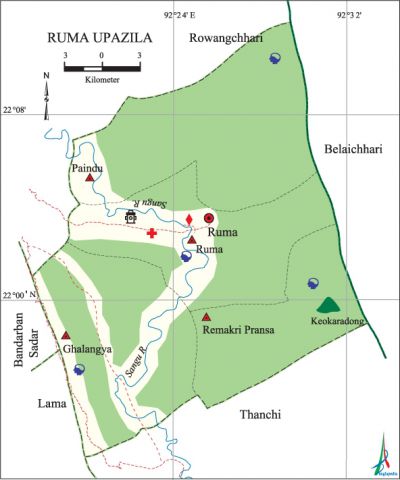Ruma Upazila
Ruma Upazila (bandarban district) area 492.10 sq km, located in between 21°53' and 22°10' north latitudes and in between 92°17' and 92°34' east longitudes. It is bounded by rowangchhari upazila on the north, thanchi upazila on the south, belaichhari upazila on the east, bandarban sadar and lama upazilas on the west.
Population Total 26589; male 14414, female 12175; Muslim 1813, Hindu 416, Buddhist 9909, Christian 11880 and others 2571. Indigenous communities such as chakma, marma, Murong and tripura belong to this upazila.
Water bodies Main river: sangu.
Administration Ruma Thana was formed in 1976 and it was turned into an upazila in 1985.
| Upazila | ||||||||
| Municipality | Union | Mouza | Village | Population | Density (per sq km) | Literacy rate (%) | ||
| Urban | Rural | Urban | Rural | |||||
|
2 |
7 |
126 |
217 |
206963 |
268196 |
2291 |
51.16 |
48.23 |
| Kanchan | ||||||||
|
Area (sq km) |
Ward |
Mahalla |
Population |
Density (per sq km) |
Literacy rate (%) | |||
|
18.16 |
- |
- |
44302 |
2440 |
49.29 | |||
| Tarabo | ||||||||
|
Area (sq km) |
Ward |
Mahalla |
Population |
Density (per sq km) |
Literacy rate (%) | |||
|
29.69 |
- |
- |
91131 |
4202 |
54.40 | |||
| Upazila Town | ||||||||
|
Area (sq km) |
Mouza |
Population |
Density (per sq km) |
Literacy rate (%) | ||||
|
16.19 |
16 |
46129 |
2849 |
49.8 | ||||
| Union | ||||
| Name of union and GO code | Area (acre) | Population | Literacy rate (%) | |
| Male | Female | |||
|
Kayet Para 55 |
6431 |
33082 |
31568 |
44.63 |
|
Golakandail 39 |
4586 |
15378 |
13062 |
49.93 |
|
Daudpur 31 |
6880 |
20065 |
19618 |
48.71 |
|
Bulta 15 |
2364 |
17082 |
15100 |
52.99 |
|
Bholaba 07 |
4252 |
16191 |
16028 |
43.28 |
|
Mura Para 63 |
2145 |
14204 |
12805 |
51.36 |
|
Rupganj 79 |
7214 |
22703 |
21310 |
46.76
|
Source Bangladesh Population Census 2001, Bangladesh Bureau of Statistics.

Historical events The Arakan king Meng Beng (known as Sultan Jabouk Shah) ruled this region for 21 years (1532-53). The Mughals invaded the area in 1666. The region was under the reign of Mraku dynasty till 1784.
Religious institutions Mosque 6, temple 1, math 7, keyang 35, ashrama 1. Noted religious institutions: Miziri Para Buddhist Temple.
Literacy rate and educational institutions Average literacy 26.7%; male 33.7%, female 18.4%. Educational institutions: college 1, secondary school 6, primary school 37, community school 6, kindergarten 1. Noted educational institutions: Ruma Government High School, Paindu Headman Para Government Primary School, Chainda Headman Para Government Primary School, Ruma Bazar Adarsha Para Government Primary School.
Cultural organisations Library 1, club 1, music academy 1, cultural organisation 3, women organisation 2, auditorium 1, playground 2.
Tourist spots Boga Lake, Tajindong Hill, Keokaradong Hill, Rejuk Fall, Miziri Para Buddhist Temple.
Main sources of income Agriculture 84.79%, non-agricultural labourer 0.88%, industry 0.42%, commerce 5.7%, transport and communication 0.1%, service 3%, construction 0.15%, religious service 0.15%, rent and remittance 0.13% and others 4.68%.
Ownership of agricultural land Landowner 40.74%, landless 59.26%; agricultural landowner: urban 43.26% and rural 40.06%.
Main crops Paddy, sesame, cotton, turmeric, ginger, nut, vegetables.
Extinct or nearly extinct crops Mustard.
Main fruits Banana, jackfruit, orange, pineapple, papaya.
Noted manufactories Saw mill, brick-field.
Hats, bazars and fairs Hats and bazars are 4, most noted of which are Ruma Bazar, Murum Ghat Bazar and Ghalangya Bazar.
Main exports Banana, papaya, pineapple.
Access to electricity All the unions of the upazila are under rural electrification net-work. However 6.74% of the dwelling households have access to electricity.
Natural resources Bamboo, stone.
Sources of drinking water Tube-well 8.09%, tap 5.36%, pond 2.69% and others 83.86%.
Sanitation 3.84% (rural 1.86% and urban 11.15%) of dwelling households of the upazila use sanitary latrines and 25.93% (rural 15.66% and urban 63.76%) of dwelling households use non-sanitary latrines; 70.23% of households do not have latrine facilities.
Health centres Upazila health centre 1, army medical centre 1, health centre 1, veterinary hospital 1.
NGO activities Operationally important NGOs are brac, caritas. [Atikur Rahman]
References Bangladesh Population Census 2001, Bangladesh Bureau of Statistics; Cultural survey report of Ruma Upazila 2007.
